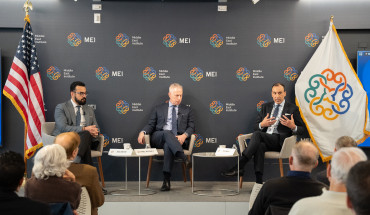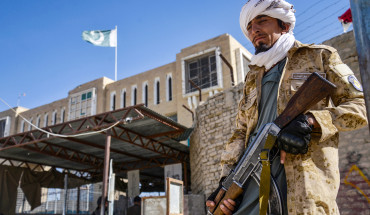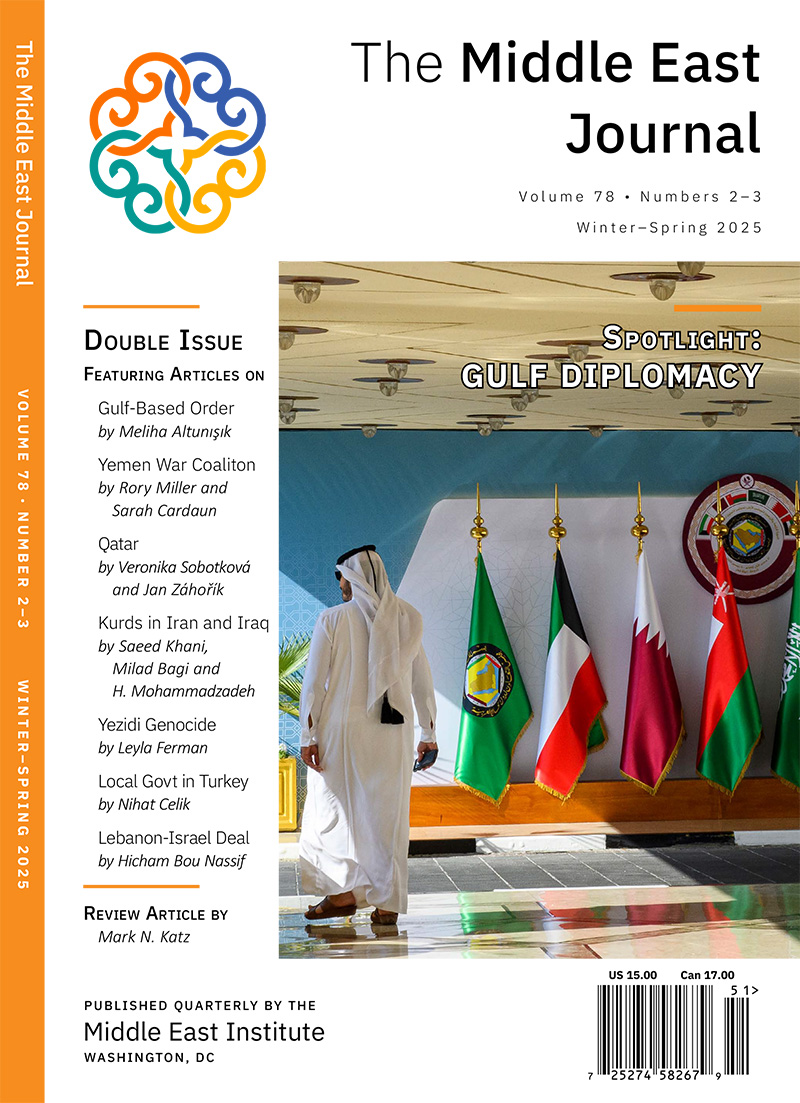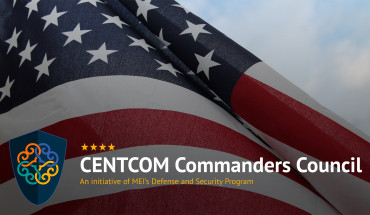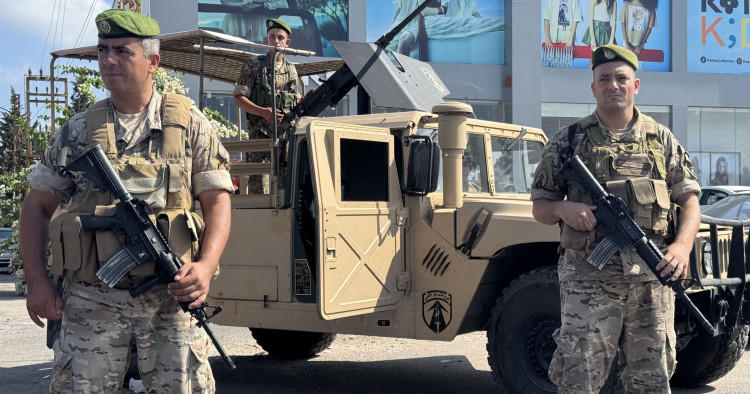The below article is part of the series "Seizing Lebanon's Moment," a joint initiative with the Italian Institute for International Political Studies (ISPI). The contributors to this series — who comprise top scholars, policymakers, and professionals from Lebanon, Europe, and the United States — set out to identify Lebanon's critical problems and propose specific reforms aimed at practitioners and officials dedicated to helping the country recover from its deep, multi-year crisis. The series has been compiled in a report, whose findings aim to carry forward the constructive policy dialogue initiated during this year's Mediterranean Dialogues Conference.
The realization of a sovereign Lebanon following the weakening of Hizballah and the collapse of Bashar al-Assad’s regime in Syria is a once-in-a-generation opportunity that must not be missed. Lebanon’s promise, however, hinges on its ability to resolve its core dysfunction: reclaiming the state’s monopoly on force and its exclusive authority to determine matters of war and peace.
The emergence of a new leadership and government committed to restoring the state’s authority has helped rehabilitate its legitimacy at home and abroad; yet Lebanon’s future remains precarious. A major obstacle is Hizballah, which emerged from its roughly year-long armed confrontation with Israel down but not out. Although weakened by the degradation of its arsenal, loss of its founding military leadership, and severing of its land supply lines through Syria, Hizballah refuses to surrender any of its of weapons deployed or stockpiled north of the Litani River. The second complication stems from Israel, which retains control of the escalation ladder and continues its military strikes against Hizballah while still occupying five hilltops in Lebanon. Though the Lebanese state has shown a willingness to take courageous steps to challenge the legitimacy of Hizballah’s weapons, the implementation of the disarmament process has yet to move beyond the extent the militia is willing to concede voluntarily.
This inherently untenable status quo has run out of steam and time. Hizballah’s willingness to disarm has largely been limited to its positions in the area between the Litani River and the Blue Line (the de facto Israeli-Lebanese border), echoing the militia’s post-2006 strategy of absorbing partial losses but holding out to buy time, regroup, and systematically undermine domestic and international confidence in the Lebanese state. That playbook, however, does not account for Israel’s new security doctrine after October 7, 2023. Whether in its decimation of Hizballah during the 2023-24 war, ongoing campaign against the Tehran-led Axis of Resistance, or direct strikes against Iran’s nuclear program, Israel has demonstrated it is prepared to act first against any threat left unresolved. Israel’s regular military strikes in Lebanon are a constant reminder that it can accelerate the tempo and intensity of the conflict at any time if the disarmament process falters. Consequently, despite its pledges otherwise, the Lebanese state still cannot determine its own path on matters of war and peace.
Against such heightened uncertainty, the United States, through its envoy Ambassador Tom Barrack, advanced a roadmap to link Israel’s gradual withdrawal with Hizballah’s phased disarmament and a resolution of the broader issues in the Israel-Lebanon conflict. That diplomatic initiative faltered early on, but a new round of military escalation is not inevitable. By leveraging its role as a guarantor of the November cease-fire and mentor of the Lebanese Armed Forces (LAF), Washington can put forward a new starting point that both Israel and Lebanon can credibly buy into to revive the step-by-step process. For this process to succeed, however, the Lebanese state, backed by deepening US support, must consistently focus on achieving tangible milestones and strategic victories that build enough momentum to turn the tide, making Hizballah’s disarmament inevitable and the state’s reassertion of authority irreversible.
The first steps toward restoring Lebanese sovereignty
The degradation of Hizballah following the 2023-24 conflict with Israel and the collapse of the Assad regime in Syria gave Lebanon its best chance of regaining sovereign statehood in more than half a century. For the first time in decades, a new president, prime minister, and government assumed office outside the sphere of influence of Syria, Hizballah, or Iran. At first, the new leadership in Lebanon was banking on the hope that Hizballah’s domestic considerations would convince it of the need to lay down its arms. Hence, the president called for a negotiated disarmament process with Hizballah — and continues to periodically repeat that mantra to this day.
The state, through the LAF, moved quickly to reestablish control over the airport (further curbing Hizballah’s ability to rearm and refinance), secured large parts of the Lebanese-Syrian border, and boosted its presence in the territory between the Litani and the Blue Line as Hizballah, facing ongoing Israeli strikes, conceded the gradual clearing of most of its military sites in this area.
But progress soon reached a standstill, as Hizballah’s compliance appeared limited to partial disarmament in the specific zone south of the Litani. When these efforts plateaued, Israel ramped up its military escalation, putting Beirut’s new leadership in an increasingly uncomfortable position. On the one hand, the Lebanese government was relying on Hizballah’s de facto cooperation to avoid the risk of internal conflict; on the other, regular Israeli strikes were a constant reminder that should Lebanon fail to disarm Hizballah, a new round of conflict with Israel could be around the corner. Adding to these pressures were clear signals from Washington, delivered by Ambassador Barrack, that while the decision was ultimately Lebanon’s to make, it would risk missing its moment if it did not commit to fully disarming Hizballah.
Signaling renewed determination to break from the past, Lebanon’s cabinet met in August, with the president and prime minister in session, and took the landmark decision to task the LAF with developing a plan to disarm Hizballah by the end of the year. The gathered ministers, the head of government, and the head of state additionally endorsed the objectives of the US (Barrack) plan that would phase Hizballah’s disarmament and Israel’s withdrawal, among other pertinent issues, to resolve the longstanding dispute between Israel and Lebanon.
The Barrack plan
At its core, the Barrack plan aims to address the dual challenges of disarming Hizballah and securing a full Israeli withdrawal along with an end to its ongoing military operations through four phases. To bolster its durability, the plan also envisions an internationally supported post-war reconstruction effort and a framework for resolving long-standing disputes, including prisoner exchanges and the permanent demarcation of Lebanon’s borders with both Israel and Syria.
In principle, the US plan offers Hizballah a dignified exit following its military defeat, linking its disarmament to issues it has long claimed to fight for: namely, the release of its prisoners, the cessation of Israeli military operations in Lebanon, resolution of the border disputes, and the full withdrawal of Israeli forces from the country. More importantly, the plan positions the Lebanese state as the only actor capable of achieving what Hizballah could not: a permanent and favorable resolution to the conflict with Israel.
The plan’s first phase, essential for the rest of the process to stick, largely focuses on securing a quick win. Beirut would officially endorse the framework and commit to disarming all non-state armed actors by the end of the year. In exchange, Israel would cease all military operations. On the surface, its logic appears straightforward. The Lebanese state would be held to its pledges to disarm Hizballah; Hizballah would further appear as a spoiler if it resisted the state’s official disarmament plan; and Israel would give the Lebanese government a win by ceasing its military operations at minimal cost given it could resume strikes any time the process faltered.
What went wrong
In early September, the LAF submitted its disarmament plan to the government, albeit with limited public details on implementation benchmarks, sequencing, or timelines. Leaks reporting a delayed timeline and narrow focus on the area south of the Litani, combined with ongoing Israeli military strikes, undermined optimism in the US-backed step-by-step roadmap. Further undercutting Beirut’s credibility was Hizballah’s deliberate defiance of the official prohibition on projecting images on Raouche Rock, a national landmark, during a commemoration event for its fallen leaders. Beyond its symbolism, the episode exposed reported internal divisions within the government and leadership, raising deeper questions about whether alignment among the political leadership or between the government and military command can hold should the state more meaningfully confront or be challenged by Hizballah.
Despite these setbacks, the idea of a step-by-step process is not the problem and should not be discarded as tried and failed. The lesson learned from the Barrack plan’s early misfire lies in getting the first step right and securing the credible commitments and follow-through required to ensure that step sticks and leads to the next. While Washington was able to get the Lebanese state to publicly endorse the plan in August, it did so without appearing to secure credible Israeli buy-in, as has been made evident by Israel’s continuous military strikes. Soon after, the LAF’s plan reportedly moved from aiming to disarm Hizballah by the end of the year to completing the disarmament of Hizballah’s military sites in the area south of the Litani in that time period. This dynamic has undermined trust in everyone involved. Israel appears as the aggressor. Beirut appears to be reverting to a passive posture, seemingly unwilling or incapable of disarming Hizballah. Hizballah appears to be reprising its post-2006 playbook, albeit in a far more adverse context. Washington, though still the indispensable mediator, has suffered a loss of credibility. As momentum on the diplomatic track stalls, the risk of military alternatives rises.
Beirut, which stands to lose the most from diplomacy’s failure, appealed to Washington to press Israel to cease its military operations. It has also tried to highlight the significance of its progress in the southern Litani area. Although the latter helped encourage US and international support for the LAF, neither Lebanese initiative has led to a cessation of Israeli military strikes or renewed all sides’ focus on the step-by-step process because they do not resolve the core strategic distrust at the heart of this early impasse. Israel views itself as the de facto enforcer of the November cease-fire and primary guarantor of its security. From the Israeli perspective, its military campaign is instrumental to curbing Hizballah’s future capabilities and serves to shape the tempo and scale of the conflict and disarmament process. Put simply, Israel appears unwilling to exchange the primary instrument it trusts — force — for assurances from Beirut it does not consider credible.
Israel’s limited trust in the Lebanese state, the LAF, and the United Nations Interim Force in Lebanon (UNIFIL) to implement their respective responsibilities to disarm Hizballah is the central obstacle that needs to be reversed if diplomacy is to succeed. Accordingly, understanding the foundations of this mistrust is critical to identifying a pragmatic entry point for reviving the step-by-step process.
The skepticism stems largely from the failure of earlier diplomatic efforts, most notably the non-implementation of UN Security Council Resolution 1701 following the 2006 war. That resolution envisioned the gradual restoration of Lebanese sovereignty and, in coordination with UNIFIL, the establishment of a buffer zone south of the Litani River. In practice, however, Hizballah exploited the resolution’s language to narrow any discussion of disarmament to the buffer zone, which it never complied with, while sidestepping earlier, clearer mandates such as Resolution 1559, which requires its complete disarmament. On the domestic front, Hizballah turned its guns inward, carrying out a series of assassinations and a military takeover of Beirut in 2008. It regularly transformed “national dialogues” on the country’s so-called “defense strategy” into euphemisms to maintain its arms rather than surrender them to the state. The result was a steady reconstitution of Hizballah’s military potency that made it the most lethal paramilitary in the world and coerced the Lebanese state into failure.
If a step-by-step process is to be meaningfully resuscitated, it has to begin with an opening move that convincingly breaks from this past dysfunction. While the Lebanese state, like any other government, has a legitimate imperative to stop Israeli military strikes on its territory that harm civilians and undermine the state’s sovereignty, it needs to come to terms with the impact that legacy of failure has on shaping a diplomatic path capable of delivering the outcome it seeks.
Such a recognition is key to understanding why the LAF’s reported focus on the zone between the Blue Line and the Litani is unlikely on its own to succeed in reigniting momentum in the step-by-step plan or in halting Israeli military strikes. The November cease-fire, explicitly designed to break from the post-2006 experience, stresses disarmament will start with the area south of the Litani and expand to the rest of the country. Therein lies the key to finding the right first step: breaking the precedent of territorially limiting Hizballah’s disarmament.
Getting the first step right
This is where Washington can put forward a new starting point: identifying a credible initiative the Lebanese could successfully implement beyond the confines of the area south of the Litani River. One obvious option within reach might be a strategically coordinated LAF operation to seize a major Hizballah weapons cache outside this traditional area of focus in line with the US-led mechanism established in the November cease-fire. Doing so would break the past precedent of focusing on a narrow buffer zone and build the LAF’s and the Lebanese state's confidence to openly challenge Hizballah’s continued intransigence. Such a targeted enforcement effort, especially if succeeded by an immediate pause in Israeli strikes, would make it difficult for a willing but still cautious government to plausibly argue that such a focused initiative could trigger internal collapse, is outside the pale of the state’s enforcement capacities, or risks the LAF endangering civilian and public safety. Should Hizballah violently retaliate to such a limited operation designed to bring about a reciprocal Israeli pause in airstrikes, it would be clearly assuming the role of aggressor, while instigating a high-risk conflict at a time of acute vulnerability.
Leveraging the Washington-led mechanism already in place, US intelligence-sharing combined with proactive shuttle diplomacy can play an instrumental role in identifying an operation the Lebanese are confident enough to implement and that the Israelis are willing to exchange for a pause in their military campaign. Securing that mutual buy-in by identifying a practical but meaningful implementation step, one that establishes a new precedent for the process of ultimately disarming Hizballah, is key to reviving the broader step-by-step process.
Whatever the starting point, the greater objective must be to find an opening move that credibly ties in both Israel and Lebanon and is strategically sequenced to deliver real successes that motivate them to keep the process alive. Early achievements, like setting the precedent of disarming Hizballah outside the area south of the Litani or ceasing Israeli military strikes, would immediately boost the roadmap’s credibility and appeal. In turn, if sustained, that boost in credibility and trust could drive momentum forward and help realize the plan’s vision of linking Hizballah’s disarmament with Israel’s withdrawal. Rather than tackling the full-scale challenge all at once, the step-by-step roadmap allows the cautious Lebanese state to focus on disarming Hizballah in manageable stages across the country (such as up to the Awali River, through the Greater Beirut area, and into the Bekaa), as a skeptical Israel reciprocates with a phased withdrawal from the five hilltops it occupies. Fixing the Barrack plan’s initial misstep to address Israel’s strategic mistrust and Beirut’s fear of overreach is a far more pragmatic and worthwhile approach than discarding it with nothing else in place.
With attention now shifting toward implementation, Washington is uniquely positioned to help identify a hinge point that addresses both Israel’s strategic mistrust and Lebanon’s concerns of overreach. Acting on that hinge point would set the stage for the Lebanese and Israelis to genuinely commit to breaking subsequent phases of Hizballah’s disarmament and Israeli withdrawal into tangible, time-bound, enforceable steps. Those follow-up steps will need adaptable support strategies from Washington, as Hizballah is likely to push back, seek to undermine the state’s resolve, and exploit any gaps in international backing. While not a barrier for the first step, the fears already exposed after the Raouche Rock episode that efforts to directly confront Hizballah will falter due to potential divisions within the political leadership, reluctance from the military command, or even the collapse of the LAF need to be accounted for in the long run.
Washington must build on its mentorship of the LAF and deepen it to decisively shift the domestic calculus on confronting Hizballah. While a major operation outside the southern Litani area may be sufficient for breaking past precedent to revive the step-by-step process, for it to set a new precedent, whereby state authorities and the LAF are united and committed to adhering to a more assertive posture, Washington will need to considerably increase its financial support, strategic guidance, and military backing. Collectively, such a strengthening of the US-LAF partnership would help build up the confidence and focus needed to overcome any threats designed to overwhelm the LAF’s or state’s capacities or break their resolve, through assassinations, heavy resistance to military operations, intimidation campaigns, or the seizing of military or public facilities, and the like.
Identifying the support required for the follow-up steps to take hold does not detract from getting step one right. On the contrary, each success strengthens the next, and the promise of future support embedded in a sequenced framework incentivizes follow-through, creating a self-reinforcing cycle where trust in the Lebanese state increases alongside its confidence to finish the job within a clear timeline. Demonstrated achievements, like moving from one phase to another, will enable the conditions for the more robust security commitments that are needed to alleviate the underlying drivers of Beirut’s caution, raise the cost of any Hizballah escalation, and compel Hizballah to concede gradual losses that accrue to a strategic defeat. If momentum takes hold after the first step, Washington and Beirut can build on it by exploring politically viable security commitments that learn from the successes of Operation Inherent Resolve (OIR) and tailor them to the new Lebanese context to help ensure Beirut has the will and capability to stay the course and overcome Hizballah’s residual ability to deter state action. While continuous US financial support for the LAF is key to maintaining and building loyalty and professionalism within the institution, considerable American military assistance to the LAF through trainers, shared intelligence, combat advisors, and fire support could bolster its ability to withstand any retaliatory violence by Hizballah and build the confidence, experience, and capacity required to ensure it sustains an assertive posture while addressing the underlying worry, real or perceived, that it would risk falling apart in the process.
Lebanon’s moment is not yet lost. The US, leveraging its dual role as guarantor of the cease-fire and mentor to the LAF, can provide Beirut with the reassurances and strategic support it needs to do the job only it can do, while simultaneously giving Israel a reliable framework and credible guarantees to trust the step-by-step process over unilateral military action. While the window to act and prevent another round of military escalation is closing, if seized by the Lebanese and sustained by a credible US- backed process, it would end not just with Hizballah’s disarmament, but with the long-awaited emergence of a truly sovereign Lebanese state finally able to determine its own fate on matters of war and peace.
Fadi Nicholas Nassar is a Senior Fellow at the Middle East Institute. The author would like to thank Paul Salem for his thoughtful contributions.
Photo by Ahmad Kaddoura/Anadolu via Getty Images
The Middle East Institute (MEI) is an independent, non-partisan, non-for-profit, educational organization. It does not engage in advocacy and its scholars’ opinions are their own. MEI welcomes financial donations, but retains sole editorial control over its work and its publications reflect only the authors’ views. For a listing of MEI donors, please click here.






